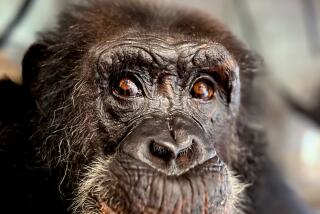An Ape for Her Very Own : EVE AND THE APES <i> by Emily Hahn (Weidenfeld & Nicolson: $17.95; 168 pp.)</i>
Gorilla gorilla, the largest primate and the last to be discovered, met the West just 10 years before the publication of “The Descent of Man,” in which Darwin suggested that a hominid very much like it was our remote ancestor. Recent genetic studies confirm our evolutionary proximity to the great apes.
Our psychological distance remains troubling. To some people, the apes represent soulless monsters. To others, they embody innocence. Of the latter, from the sentimental to the solidly scientific, many have been female. In “Eve and the Apes,” Emily Hahn chronicles the adventures of nine women, who for a variety of reasons, raised one or more infant apes.
Baby apes bear an uncanny resemblance to human infants. Piaget’s tests reveal that gorillas develop in the same stages as children. Small apes are at least as mischievous and certainly as affectionate as children. The temptation to indulge them is easy to understand. So is the fact that many of their guardians forget that in spite of their intelligence they are not human.
Hahn, who has nurtured her own pet monkeys from time to time, recounts the adventures over almost a century of a handful of Western women and their apes. Some were reared in luxury, others in not-so-genteel poverty, some in the United States and some returned tentatively to what remains of their natural habitats.
Hahn’s selections are idiosyncratic. She omits Jane Goodall and Diane Fossey because, she explains, they have written their own stories. Yet almost all of those she does include wrote at least one account of their lives with their apes, and Hahn relies heavily on their books.
With few exceptions, most of the women Hahn describes made little effort to distance themselves from the animals. Indeed, Hahn says in obvious admiration that Belle Benchley, the remarkable director of the San Diego Zoo, was “never guilty of detachment.” She never hesitated to anthropomorphize the apes--to project onto them human motivations. But there is a great contrast between Benchley’s accomplishment in building a great zoo and that of the rich eccentric Augusta Hoyt, who raised an infant gorilla like a spoiled child until he grew too difficult to manage, and then arranged for him to join the circus. While both women were emotionally involved with their charges, they had quite different ideas of what was good for the apes.
Hahn, a New Yorker staff writer, moves deftly in more or less chronological order, dropping some of the best tidbits in captivating digressions. She reminds us, for instance, of the contributions of Robert Yerkes, the Yale psychologist who, with his wife, Ada, wrote the first comparative study of the apes. Yet she omits discussing Ada because her primary interest was botany, not anthropology. But she does not hesitate to devote a chapter to Barbara Harrison, who once lived in Indonesia with orangutans, but now curates a ceramics museum in Holland.
Unlike her 1971 history of the U.S. Primate Centers, “On the Side of the Apes,” this book covers little new ground. It is, rather, a retelling of old stories supplemented with occasional on-the-spot interviews with those women who happened to have been available for a chat.
Her approach is casual as she quotes freely without bothering to check the facts. Contrary to the assertion that “a solitary ape is a man-made freak,” many male gorillas and all male orangutans live solitary lives as soon as they mature. Birute Galdikas is Lithuanian, not Greek, and David Hamburg is not a primatologist but a psychiatrist who was at one time head of the National Institute of Medicine and is currently president of the Carnegie Corp. of New York.
“Eve and the Apes” describes an era when endangered species seemed abundant, and chimpanzees, gorillas and orangutans were prized for their ability to attract a crowd. From today’s more compassionate view of the apes we can wonder whose behavior was more reprehensible--the circus chimp who bit off the finger of his captor, or the man who gave orders from his hospital bed that the finger be preserved as an exhibit to attract customers. How can one not admire the Primate Foundation in Arizona, which serves as a home of last resort for geriatric chimpanzees whose careers in carnivals are over?
Hahn tells us that the foundation occasionally lends out its chimpanzees to scientists, but only when assured that the research is benign. “Research,” she quotes Jo Fritz who runs the Foundation, “that’s a fighting word with some people. A dirty word.” Hahn doesn’t comment on this timely issue, but perhaps she is saving that for another book.
More to Read
Sign up for our Book Club newsletter
Get the latest news, events and more from the Los Angeles Times Book Club, and help us get L.A. reading and talking.
You may occasionally receive promotional content from the Los Angeles Times.







